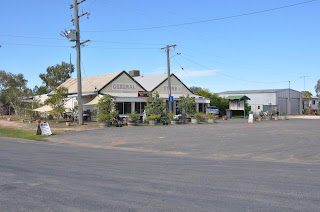Canberra: 23 August [781 km]
Well; we have finally arrived at the final day of our great adventure. This was to be the longest driving day of our trip but much of this driving would be on familiar roads.
On a very windy day, we said goodbye to Rick and Janene (and Milo) and set off for Uralla. The statue of Captain Thunderbolt is prominent in the main street of Uralla – on the corner of the New England Highway and Thunderbolt’s Way.
As the wind blew across the high
plains, we drove through Walcha and then through the spectacular mountain
country along the edge of the Great Dividing Range. Some of the views from this road are amazing,
such as this view to the south across a multitude of mountains and valleys. It is an extremely rugged but beautiful area.
Travelling south, the road falls quite
dramatically to the valley of the Manning River (the river, which comes out at
Taree, is very small at this point). We
pressed on to Gloucester where we were sheltered from the strong wind and we
enjoyed morning tea in the warm sunshine.
Then we continued to the Pacific Highway – a road that is very familiar
to us.
Once we had reached this point, we
knew that we simply had to press on to Canberra – and that is what we did, with
the strong wind as our constant companion.
Our journey on the M7 through Sydney was smooth and we soon arrived at
Sutton Forrest. As we left after
afternoon tea, we drove into low cloud and rain near Goulburn. We hadn’t seen rain since leaving Perth all
those weeks ago!
We arrived home in Isabella Plains at 6.30 pm and gave Tinkerbell a warm welcome. She seemed pleased to see us but she appeared to have become more frail while we had been away. We also think that Chanticleer was relieved to be home after travelling more than 15,000 in 11 weeks. He deserved a bit of a rest too! Brief summary
After nearly 11 weeks on the road and
more than 15,000 kilometres (or 18,600 by including our tour around the
Kimberleys), we had driven a substantial way around the Australian mainland and
had experienced a wide range of fabulous activities. We had seen an enormous variety of landforms,
of vegetation, of coastal scenery, of animals both on land and in the sea and
we had met a large number people – old friends and new friends amongst
others.
At this early stage, we have packed so much into 11 weeks that it is difficult to think through in detail all that we have done. There is no doubt, however, that we have had an extra-ordinary adventure – and this has been an adventure that has achieved some notable ambitions, particularly for Tim. The tour of the Kimberleys, especially the visit to Mitchell Falls and to the Bungle Bungles, and walking in Carnarvon Gorge were two particular ambitions. For both of us, swimming with the whale sharks was an absolutely unbelievable experience, as was snorkelling on Ningaloo Reef; the tour to the Horizontal Falls was exhilarating in the extreme (wow!); Katherine Gorge, Edith Falls and Bitter Springs were superb spots.
At the same time, we have travelled an
enormous distance. This has meant that,
at times, we have covered long distances in a day and travelled through eucalypt
forests, flat, flat plains, scrub and savannah.
We have seen, again in some instances, what a wonderful country
Australia is. Its size; its diversity; its amazing animals, birds and sea life; its people.
In some ways, reflecting on all that we have done and achieved will take a bit of time. Writing this diary of our trip has been an important part of our trip. We trust that our experiences might encourage you to consider having a look – or another look – at what our great country has to offer.
It is always good to be in your own
home – but what a fabulous time we have had looking at our country. Of course, we are already planning further
journeys: some to places to which we would like to return and others to new
places.
Go for it!


















































